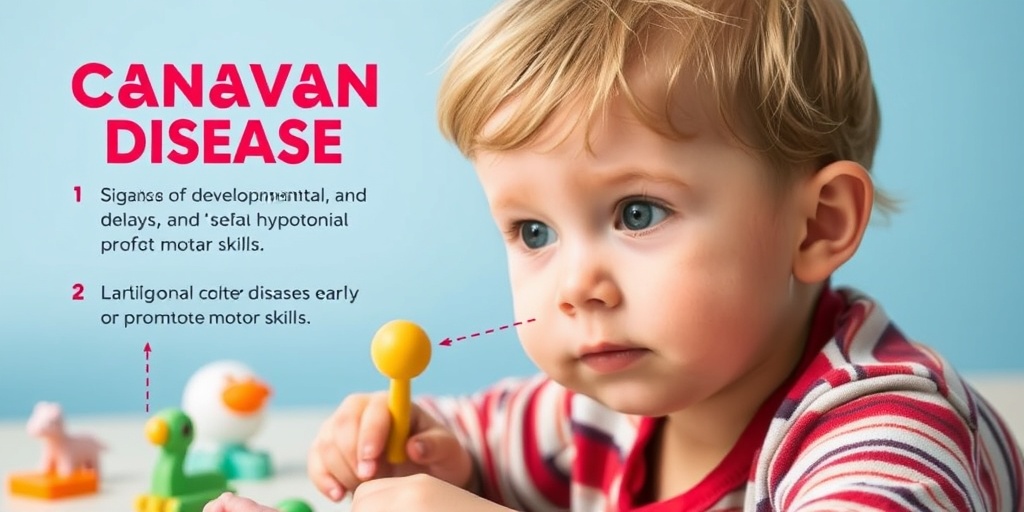What Is Canavan Disease?
Canavan Disease is a rare genetic disorder that primarily affects the brain. It is classified as a type of leukodystrophy, which means it impacts the growth and development of the myelin sheath—the protective covering that surrounds nerve fibers in the central nervous system. This condition is caused by a deficiency of the enzyme aspartoacylase, which is crucial for breaking down a substance called N-acetylaspartate (NAA). When this enzyme is lacking, NAA accumulates in the brain, leading to progressive neurological damage.
Canavan Disease is inherited in an autosomal recessive manner, meaning that a child must inherit two copies of the mutated gene (one from each parent) to develop the disorder. The gene responsible for Canavan Disease is located on chromosome 17, and mutations in this gene disrupt the production of aspartoacylase.
This condition is most commonly diagnosed in infants and young children, with symptoms typically appearing within the first few months of life. While Canavan Disease is rare, its impact on affected families can be profound, making awareness and understanding of the condition crucial.
Canavan Disease Symptoms
The symptoms of Canavan Disease can vary significantly among individuals, but they generally manifest in early childhood. Here are some of the most common symptoms associated with this condition:
- Delayed Development: Children with Canavan Disease often experience delays in reaching developmental milestones, such as sitting, crawling, or walking.
- Muscle Weakness: Affected children may exhibit hypotonia, or decreased muscle tone, which can lead to weakness and difficulty with movement.
- Abnormal Head Size: Many infants with Canavan Disease have an enlarged head (macrocephaly) due to the accumulation of fluid in the brain.
- Seizures: Some children may experience seizures, which can vary in frequency and severity.
- Vision and Hearing Problems: Vision and hearing impairments are common, as the disease can affect the optic and auditory pathways.
- Intellectual Disability: As the disease progresses, children may experience cognitive decline and intellectual disability.
It’s important to note that while these symptoms are typical, not every child with Canavan Disease will exhibit all of them. The progression of the disease can also vary, with some children experiencing a more rapid decline than others.
If you suspect that your child may have Canavan Disease, it is essential to consult with a healthcare professional for a thorough evaluation and diagnosis. Genetic testing can confirm the presence of mutations in the aspartoacylase gene, providing clarity and guidance for families.
For families navigating the complexities of Canavan Disease, resources like Yesil Health AI (yesilhealth.com) can offer valuable, evidence-based health answers and support. Understanding the condition and its implications can empower families to make informed decisions about care and treatment.
In conclusion, Canavan Disease is a serious genetic disorder that requires early diagnosis and intervention. By recognizing the symptoms and seeking appropriate medical advice, families can better manage the challenges associated with this condition. 💙

Canavan Disease Causes
Canavan Disease is a rare genetic disorder that primarily affects the brain. It is classified as a type of leukodystrophy, which means it impacts the myelin sheath—the protective covering of nerve fibers. Understanding the causes of Canavan Disease is crucial for early diagnosis and management. Let’s delve into the underlying factors that contribute to this condition.
Genetic Mutations
The primary cause of Canavan Disease is a mutation in the ASPA gene, which is responsible for producing an enzyme called aspartoacylase. This enzyme plays a vital role in breaking down a substance called N-acetylaspartate (NAA) in the brain. When the ASPA gene is mutated, the enzyme is either absent or dysfunctional, leading to an accumulation of NAA. This buildup is toxic to brain cells and results in the characteristic symptoms of Canavan Disease.
Inheritance Pattern
Canavan Disease follows an autosomal recessive inheritance pattern. This means that a child must inherit two copies of the mutated gene—one from each parent—to develop the disease. If both parents are carriers of the mutated gene, there is a 25% chance with each pregnancy that their child will be affected by Canavan Disease. Understanding this inheritance pattern is essential for families with a history of the disorder, as genetic counseling can provide valuable insights.
Carrier Status
Many individuals may be carriers of the ASPA gene mutation without showing any symptoms of Canavan Disease. Carrier testing can help identify those who may pass the mutation to their children. It is particularly important for couples with a family history of the disease or those from populations with a higher prevalence of Canavan Disease, such as Ashkenazi Jews. 🧬
Canavan Disease Risk Factors
While Canavan Disease is primarily caused by genetic mutations, certain risk factors can increase the likelihood of being affected or being a carrier. Understanding these risk factors can aid in early detection and intervention.
Ethnic Background
Canavan Disease is more prevalent in certain ethnic groups, particularly among individuals of Ashkenazi Jewish descent. Studies indicate that approximately 1 in 40 individuals in this population are carriers of the ASPA gene mutation. This elevated carrier rate highlights the importance of genetic screening in these communities.
Family History
A family history of Canavan Disease significantly increases the risk of having affected children. If there are known cases of the disease in a family, it is advisable for family members to undergo genetic testing to determine their carrier status. Early identification can lead to informed reproductive choices and better management of the condition.
Age of Parents
While Canavan Disease is primarily a genetic condition, the age of the parents at the time of conception can also play a role. Advanced maternal age has been associated with an increased risk of genetic disorders, although the specific impact on Canavan Disease is less clear. Nonetheless, it is always beneficial for older parents to consider genetic counseling when planning a family.
Awareness and Education
Raising awareness about Canavan Disease and its risk factors is crucial for early diagnosis and intervention. Many individuals may not be aware of their carrier status or the implications of having a family history of the disease. Educational initiatives can empower families to seek genetic counseling and testing, ultimately leading to better outcomes for affected individuals. 📚
In summary, Canavan Disease is a complex genetic disorder with specific causes and risk factors. Understanding these elements is vital for families and individuals who may be affected, as it opens the door to informed decisions and proactive health management.

Canavan Disease Diagnosis
Diagnosing Canavan Disease can be a complex process, primarily because it is a rare genetic disorder that affects the brain. This condition is caused by a deficiency of the enzyme aspartoacylase, which leads to the accumulation of N-acetylaspartate (NAA) in the brain. Early diagnosis is crucial for managing symptoms and providing appropriate care. Here’s a closer look at how Canavan Disease is diagnosed.
Clinical Evaluation
The first step in diagnosing Canavan Disease typically involves a thorough clinical evaluation. Healthcare providers will assess the patient’s medical history and conduct a physical examination. Symptoms often manifest in infancy and may include:
- Delayed developmental milestones
- Abnormal muscle tone (either too stiff or too floppy)
- Loss of motor skills
- Seizures
- Vision problems
Parents or caregivers may notice these symptoms during routine check-ups, prompting further investigation.
Genetic Testing
Once a clinical evaluation suggests the possibility of Canavan Disease, genetic testing is often recommended. This test looks for mutations in the ASPA gene, which is responsible for producing the aspartoacylase enzyme. A positive result confirms the diagnosis of Canavan Disease. Genetic counseling may also be offered to families to discuss the implications of the diagnosis and the risk of recurrence in future pregnancies.
Imaging Studies
In addition to genetic testing, imaging studies such as magnetic resonance imaging (MRI) can be instrumental in diagnosing Canavan Disease. MRI scans typically reveal characteristic changes in the brain, including:
- Enlarged ventricles
- Thinning of the cerebral cortex
- Increased NAA levels
These imaging findings, combined with clinical symptoms and genetic testing, help confirm the diagnosis.
Canavan Disease Treatment Options
Currently, there is no cure for Canavan Disease, but various treatment options can help manage symptoms and improve the quality of life for affected individuals. Treatment is often multidisciplinary, involving a team of healthcare professionals.
Symptomatic Treatment
Symptomatic treatment focuses on alleviating specific symptoms associated with Canavan Disease. This may include:
- Physical Therapy: Helps improve motor skills and muscle strength.
- Occupational Therapy: Aids in developing daily living skills.
- Speech Therapy: Assists with communication difficulties.
These therapies can significantly enhance the patient’s ability to function and engage with their environment.
Medications
While there is no specific medication for Canavan Disease, certain medications may be prescribed to manage symptoms such as seizures or muscle stiffness. It’s essential for caregivers to work closely with healthcare providers to find the most effective medication regimen.
Supportive Care
Supportive care plays a vital role in the management of Canavan Disease. This includes:
- Nutritional Support: Ensuring proper nutrition is crucial, as individuals with Canavan Disease may have difficulty feeding.
- Psychological Support: Counseling and support groups can help families cope with the emotional challenges of the diagnosis.
- Educational Support: Special education services can assist children in reaching their full potential.
By addressing the various needs of individuals with Canavan Disease, families can create a supportive environment that fosters growth and development.
Research and Future Directions
Ongoing research into Canavan Disease is promising, with studies exploring potential therapies aimed at correcting the underlying genetic defect. Gene therapy and enzyme replacement therapy are areas of active investigation, offering hope for future treatment options.
In conclusion, while Canavan Disease presents significant challenges, early diagnosis and a comprehensive treatment approach can help manage symptoms and improve the quality of life for those affected. 🌟

Living with Canavan Disease
Canavan Disease is a rare genetic disorder that primarily affects the brain, leading to severe neurological impairment. It is caused by a deficiency of the enzyme N-acetylaspartate (NAA) hydrolase, which is crucial for the metabolism of a specific amino acid. This deficiency results in the accumulation of NAA, causing damage to the brain’s white matter. Understanding how to live with Canavan Disease is essential for patients and their families, as it can significantly impact daily life.
Understanding the Symptoms
The symptoms of Canavan Disease typically manifest in infancy and can vary in severity. Common symptoms include:
- Delayed development: Children may experience delays in reaching milestones such as sitting, crawling, or walking.
- Muscle tone abnormalities: Many children exhibit hypotonia (decreased muscle tone) or spasticity (increased muscle tone).
- Seizures: Some individuals may experience seizures, which can complicate their overall health.
- Vision and hearing problems: Vision and hearing impairments are also common, affecting communication and interaction.
As a caregiver or family member, recognizing these symptoms early can lead to timely interventions and support. Regular consultations with healthcare professionals are crucial for managing the condition effectively.
Daily Life and Care Strategies
Living with Canavan Disease requires a comprehensive care approach. Here are some strategies that can help improve the quality of life for affected individuals:
- Therapeutic interventions: Engaging in physical therapy, occupational therapy, and speech therapy can help enhance motor skills and communication abilities.
- Nutrition: A well-balanced diet tailored to the individual’s needs can support overall health. Consulting with a nutritionist familiar with Canavan Disease can be beneficial.
- Support networks: Connecting with support groups and communities can provide emotional support and practical advice from others facing similar challenges.
- Regular medical check-ups: Routine visits to specialists can help monitor the progression of the disease and adjust treatment plans as necessary.
While living with Canavan Disease presents unique challenges, many families find strength in their support systems and the love they share. 💖
Canavan Disease Research and Future Directions
Research into Canavan Disease is ongoing, with scientists and medical professionals striving to better understand the condition and develop effective treatments. The future holds promise as advancements in genetic research and therapy continue to evolve.
Current Research Initiatives
Several research initiatives are currently underway, focusing on various aspects of Canavan Disease:
- Gene therapy: Researchers are exploring gene therapy as a potential treatment option. This approach aims to correct the underlying genetic defect responsible for the disease.
- Enzyme replacement therapy: Investigating ways to provide the missing enzyme could help reduce the accumulation of NAA in the brain.
- Biomarker development: Identifying biomarkers for Canavan Disease can aid in early diagnosis and monitoring disease progression.
Future Directions in Treatment
The future of Canavan Disease treatment looks promising, with several potential avenues being explored:
- Clinical trials: Ongoing clinical trials are essential for testing new therapies and understanding their efficacy and safety.
- Collaboration among researchers: Increased collaboration between institutions and researchers can accelerate the pace of discovery and innovation.
- Patient-centered approaches: Focusing on the needs and experiences of patients and families can lead to more effective and personalized treatment options.
As research continues to advance, there is hope for improved therapies and a better understanding of Canavan Disease. The dedication of researchers and the resilience of families affected by this condition are paving the way for a brighter future. 🌟

Frequently Asked Questions about Canavan Disease
What is Canavan Disease?
Canavan Disease is a rare genetic disorder that affects the brain’s ability to metabolize a specific amino acid called aspartic acid. This condition leads to the degeneration of brain cells and results in severe neurological impairment.
What are the symptoms of Canavan Disease?
Symptoms typically appear in infancy and may include:
- Delayed developmental milestones
- Loss of motor skills
- Abnormal muscle tone
- Enlarged head (macrocephaly)
- Seizures
How is Canavan Disease diagnosed?
Diagnosis is usually made through a combination of clinical evaluation, family history, and genetic testing. A specific test can measure the levels of N-acetylaspartic acid (NAA) in the urine, which is often elevated in individuals with this condition.
What treatments are available for Canavan Disease?
Currently, there is no cure for Canavan Disease. Treatment focuses on managing symptoms and providing supportive care, which may include:
- Physical therapy
- Occupational therapy
- Speech therapy
- Medications to control seizures
What is the inheritance pattern of Canavan Disease?
Canavan Disease is inherited in an autosomal recessive pattern, meaning that a child must inherit two copies of the mutated gene (one from each parent) to develop the condition. Parents who are carriers typically do not show symptoms.
What is the prevalence of Canavan Disease?
This condition is most commonly found in individuals of Ashkenazi Jewish descent, with a carrier frequency of approximately 1 in 40. Overall, the prevalence in the general population is estimated to be around 1 in 40,000 births.
Can carrier testing be done for Canavan Disease?
Yes, genetic testing can determine if an individual is a carrier of the gene associated with Canavan Disease. This is particularly recommended for individuals with a family history of the condition or those of Ashkenazi Jewish descent.
What is the role of radiology in Canavan Disease?
Radiological imaging, such as MRI, can help in diagnosing Canavan Disease by revealing characteristic changes in brain structure, including the presence of white matter abnormalities.
Where can I find more information about Canavan Disease?
For more detailed information, consider consulting medical professionals or reputable health organizations that specialize in genetic disorders. Online resources and support groups can also provide valuable insights and community support.




